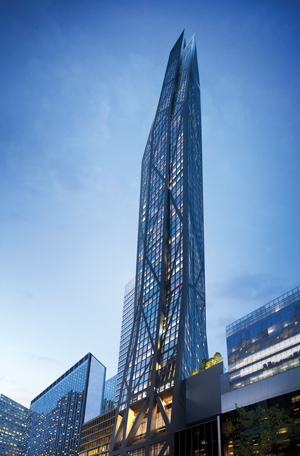Trending
A deconstructivist tower under construction
Starchitect Jean Nouvel breaks down the skyscraper at the rising 53W53

In 2007, one year before Jean Nouvel won the coveted Pritzker Prize, his firm was awarded a commission to develop a large plot of land 100 feet west of the Yoshio Taniguchi-designed expansion of the Museum of Modern Art on West 53rd Street. Only recently, however, has that plot begun its physical transformation into 53W53 [TRDataCustom], which is rising at a rate of one or two stories a week and, as of last month, was up to 29 floors. Already its dark, sloping facades are imposing themselves on 53rd and 54th streets. The lucky 1 percenters who’ve purchased apartments should be able to move in — or at least move their stuff in — in early 2019.
This 82-story, 145-unit tower, developed by Hines, Pontiac Land Group and Goldman Sachs, was originally slated to be 1,250 feet tall, which would have made it as high as the Empire State Building without the antenna. Although that height may not sound exceptional today, it certainly seemed exceptional when the building was first proposed 10 years ago. At the time, Christian de Portzamparc’s One57 had yet to kick off the super-tall residential tower craze on 57th Street, and the idea of a 1,250-foot residential building seemed almost like madness. The Department of City Planning demanded that 200 feet be lopped off the top, reducing 53W53 to 1,050 feet tall.
The likely condo buyers at 53W53rd could fairly be described as the collecting class, since many units are apt to be full of works by blue-chip artists that were bought from major auction houses and Chelsea galleries. Surely the owners will enjoy being joined, almost literally, at the hip with the Museum of Modern Art. The land on which the building stands belonged to MoMA, which sold it to Hines for $126 million in 2006, not including the air rights, which it also sold to Hines. The land’s physical and spiritual connection to MoMA was not, however, severed by the sale. The museum will have additional gallery space in 53W53, from the second through the fifth floors. Moreover, the purchasers of units in 53W53 will get free admission to the museum forever, since those privileges will be transferred along with each unit’s deed, rather like the coveted keys to Gramercy Park. Other amenities of 53W53 are standard super-luxury fare: wine vaults, a gym and swimming pool and a lounge on the 47th floor whose commanding Central Park views will console those inhabitants of the lower floors.

Jean Nouvel
Nouvel’s dominant style has, to date, been neo-modernism, which tends to be relentlessly rectilinear and modular. One sees the influence of this style in Paris in Nouvel’s Fondation Cartier and in the Institut du Monde Arabe — which also had elements of postmodern contextualism — as well as 40 Mercer Street in Soho, completed in 2006. At the same time, Nouvel has occasionally indulged in what, to use a disputed term, could be called the deconstructivist style. This inclination is evident in the syncopated surface of 100 11th Avenue, on 19th Street, which was completed in 2010.
Nouvel’s latest building on 53rd Street, however, pushes into boldly deconstructivist territory. It is a complex work in which the deconstructivist element that was mere surface treatment at 100 11th Avenue becomes an integral part of the structure. As of today, this block-through building presents itself as a dark, solid structure whose reinforced concrete skeleton is clad in dark metal and darkly hued windows. Because of its concrete core, the building has a most pre-war solidity — a heft that is surely rare in contemporary architectural practice, especially in value-engineered New York City.
Two design elements define 53W53rd. The first is its irregularly tapering volumes. These look to be part of the general deconstructivist philosophy of forms. But there is also a very local inspiration. In 1916, the city introduced a zoning code that determined the spatial envelope that a Manhattan high-rise must occupy, based on the complex relation of its height to its footprint. This ordinance resulted in a famous series of drawings by the architect and theoretician Hugh Ferris, reproductions of which are hanging in the 53W53 showroom in the Squibb Building on Fifth Avenue. These drawings depict the steps by which a building evolved under the new code. At 53W53, Nouvel appears to have those drawings in mind, but he leaves his forms in a primordial, half-baked condition, avoiding the consummation — the smoothing out of the edges — that we find in the Chrysler Building and Rockefeller Center.
In a sense, Nouvel is trying to turn the constraints of building in New York to his benefit. The form of 53W53 “evolved from an embrace of the unpredictable,” according to Bertram Beissel von Gymnich, the head of Nouvel’s New York office.

Bertram Beissel von Gymnich
“It was an attempt to exploit the arbitrary constraints imposed upon us by the building code,” Beissel von Gymnich said. Although the building is roughly geometric along its northern exposure, its southern facade on 53rd buckles and swerves as if it were melting away.
The other element of 53W53’s design is the “diagrid,” the structure’s crisscrossing surface treatment, which has parallels in Norman Foster’s Hearst Building on Eighth Avenue and 57th Street, and in Gordon Bunshaft’s 9 West 57th Street. But whereas those examples extended the diagrid in a regular pattern over parts of their buildings, 53W53 does so in an irregular and syncopated way that is as much influenced by stylistic concerns as by engineering considerations.
The building’s interiors, by Thierry Despont, are just as striking, although in a different way. A stunning mock-up apartment in the sales office shows delightful spaces that avoid the deconstructivist vocabulary of the exterior. The residential areas favor a precise, clean neo-modernism, while the building’s communal spaces are conceived in a more moderne style, a compromise between modernism and classical elegance.
The ultimate success of Nouvel’s building remains to be seen, but based on the construction so far, it’s clear that 53W53 will be manufactured to the highest conceivable standards, and there is always beauty in that. More pertinently, perhaps, the major aesthetic consequence of a building like 53W53, which embodies the deconstructivist idiom, consists not so much in its formal terms or details as in its an unforgettable presence. Nothing in architecture is less predictable than the power of an intentionally incomplete design, and 53W53 is off to a promising start.




